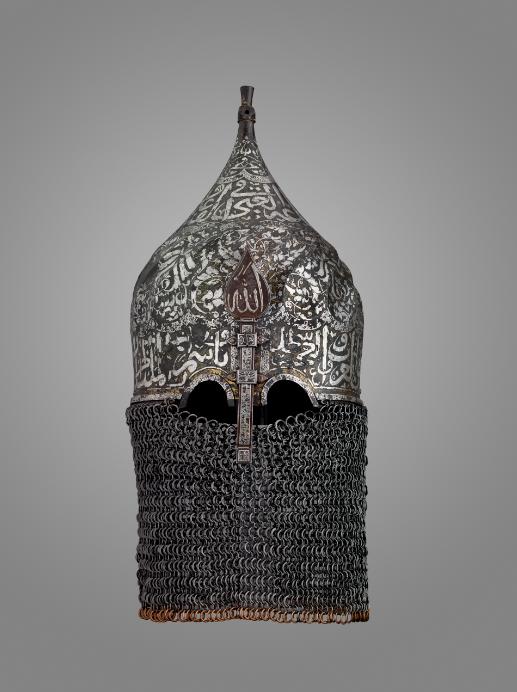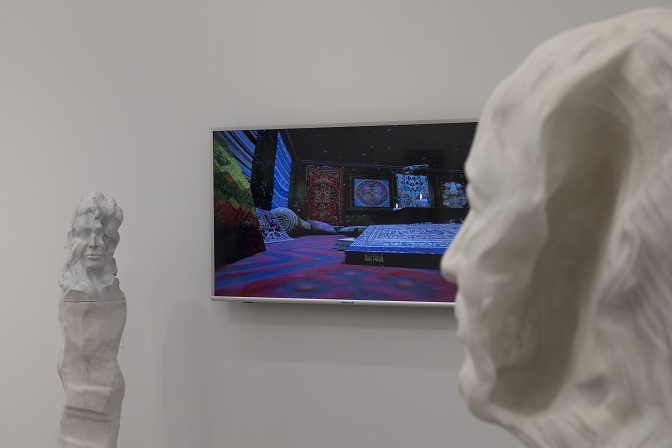Attending Christie’s London was a great privilege for me, as it allowed me to experience the extensive exhibition of Wallace Chan: “The Wheel of Time,” showcasing Europe’s largest collection of the master jewelry artist.
Featuring over 150 distinct jewelry items, the exhibition presented a selection of the artist’s renowned designs. Furthermore, this event introduced approximately 20 unseen pieces as well as a compilation of titanium and iron sculptures. These artistic creations embody Chan’s six groundbreaking concepts and illuminate the significant milestones of his extraordinary half-century carreer.

By showcasing this exclusive exhibition, Christie’s is emphasizing its dedication to supporting artists and the progression of their artistic journeys. It also serves as a testament to the longstanding partnership between Christie’s and Wallace Chan.
Wallace Chan’s artwork has been showcased in previous exhibitions at Christie’s in Hong Kong and Shanghai, further solidifying their collaborative relationship.
Usually utilized for auctions, the three rooms exclusively assigned for the exhibition on the second floor serve a dual purpose. In addition to crafting the artworks and sculptures, Chan was also responsible for fabricating the diverse display cases and conceptualizing the rooms overall appearance.

Everything was amazingly organized and presented,from the exhibition itself to the artist talk at V&A museum, the artist tours where Mr. Chan explained in detail, with great patience his artistic vision, concept and DNA, interviews and the press dinner that gathered talented journalists, curators and the team that made all this possible.
Christie’s even had an organized tour at the British Museum to view Mr. Chan’s art piece, which is part of the museum’s permanent collection in the contemporary section of the Chinese gallery.
A skilled sculptor and jewellery artist, Wallace Chan, has reshaped contemporary jewellery by adding a dreamy effect to his innovative techniques.
Chan, who was born in Fujian, China in 1956, discovered his talent for art at a young age and started crafting plastic flowers when he was just eight years old. When he turned 16, he joined a conventional workshop as an apprentice to a sculptor, but he decided to leave after a while and focus on improving his abilities in creating raised intaglio and sunken cameo reliefs. Throughout the years that followed, Chan explored a diverse range of methods and materials. Over time, Chan’s production started to reveal themes such as nature, philosophy and sculptural elements.
His creation of butterflies and flowers embodies an artistic lavish style, while his sculptural works exude a traditional Romantic aesthetic.
His artistry have something unique and captivating.
Once you’re in front of his creations, a new world opens up for you.I asked myself repeatedly while watching the exhibition, “How is this physically possible?”
But I found out that Mr. Chan is an innovator as well, and his love for creating has pushed him to discover new technologies, create his own tools, and study over the years how to adapt some of the materials to his unique creations.
Several innovations have been developed by him, driven by his creativity and curiosity. In 1987, he invented the illusionary three-dimensional carving technique called “The Wallace Cut” that is used in the famous necklace “ The Hours” and the oversized broche carved in smoky quartz. Being in the front of these creation it’s a whole new feeling.
He has also mastered titanium in the field of jewelry-making,he have a patented technology for enhancing the luminosity of jadeite and he invented intricate gemstone settings, eliminating the need for metal claws.
To add an air of mystery, he created the “Secret Abyss” set with yellow diamond, quartz, emerald, amethyst and diamonds. where more than a thousand emeralds were set inside a block of rutilated quartz through a small opening.
The Chinese inventor is a precursor in titanium jewellery. Its genius recognized the potential of the modern material for its lightness, hardness and its colouring ability, which strongly supports Chan’s creativity.

The cut technique seen in “The Hours” necklace by Wallace Chan
Wallace Chan Cut Technique in smoky quartz Carving and sculpture with titanium, diamond, ruby, tsavorite garnet, purple and pink sapphire
Lastly, his most recent invention is The Wallace Chan Porcelain, a material that is five times harder than steel. It took seven years to research, experiment, and develop The Wallace Chan Porcelain, but the process itself had been in progress for decades. The inspiration for this material came from the creator’s childhood memory of a porcelain spoon dropping and breaking on the floor. Despite its apparent durability, he believed that porcelain should possess strength that is equivalent to the centuries of historical significance it represents.
With a strength five times greater than steel, The Wallace Chan Porcelain is deeply connected to culture and history. It boasts vibrant colors, striking glossiness, robustness, resilience, and a modern essence.
The British Museum has had “A New Generation,” which was made with The Wallace Chan Porcelain since 2019, as part of their permanent collection. It is the first contemporary jewelry artwork by a Chinese artist to be included in the museum’s collection. During a tour arranged by Christie’s, I had the honor of seeing it in person in the Chinese section of the renowned Museum.
Sapphire, Aquamarine, Diamond, The Wallace Chan Porcelain and Titanium
In 2002, Wallace Chan received another patent for his invention of a technique that enhances the light and appearance of jade by manipulating its surface.
The technique creates a mesmerizing effect as the light bursts and travels along the surface of the jade, causing the green colors to intensify and become more vibrant.

Half a century of art and innovation under one roof made me spent hours viewing the entire exhibition with excitement and curiosity.
You can delve into his soul and philosophy through his works, and the sense of awe will linger with you for a long time.
Another interesting event of the show was the talk that Mr. Chan had at the V&A Museum, an event that gathered an impressive crowd:journalists, jewelry designers seeking inspiration and knowledge, art collectors or enthusiasts who wanted to find out more about his work and philosophy.
At the esteemed museum in London, Chan delivered the “Talk” in which he expressed his aspirations to create artwork that will endure indefinitely.
The theme of his talk was based on a traditional Chinese expression, “Everything, big or small, is infinite.”
“It suggests that regardless of size or scale, there is infinity within all things,” Chan told the audience. “It means that even the smallest or seemingly insignificant elements have the potential for greatness and limitless depth. It encourages us to recognize that the grandeur of the universe and existence can be found within the tiniest details, and that there is a continuous interconnectedness between the microcosm and the macrocosm.”

A foundation for all of his work is described by him using this expression. No matter if it involves small gems and diamonds or utilizing these materials as building components for his grand and intricate jewels, the idea of the interconnection between big and small is consistently present.
Chan presented a new artwork at the exhibition called the “Legend of the Color Black.” This artwork included a black diamond that weighed 312.24 carats, which made it one of the biggest cut black diamonds globally. During his presentation, he expressed how this precious gem inspired him to design a shoulder brooch that combines his interest in human DNA and neurons as the foundation of existence, along with the enigmatic properties of a black diamond.
He said:“Every work of mine is either a self- portrait or a metaphor of the creative process. An artist sculpts not only with intention but with purpose, like how nature sculpts neurons through synaptic pruning. The delicate balance of creation and deconstruction mirrors the artistic process itself. Every stroke finds its place and every unnecessary element is delicately pruned away. The brooch’s structure, a painstaking result of both artistry and engineering, finds its roots in sculpted titanium, a reflection of the axons that stretch like branches of thought, seeking connection, communicating across the neural landscapes.”
He said,“Every work of mine is either a self- portrait or a metaphor of the creative process. An artist sculpts not only with intention but with purpose, like how nature sculpts neurons through synaptic pruning. The delicate balance of creation and deconstruction mirrors the artistic process itself. Every stroke finds its place and every unnecessary element is delicately pruned away. The brooch’s structure, a painstaking result of both artistry and engineering, finds its roots in sculpted titanium, a reflection of the axons that stretch like branches of thought, seeking connection, communicating across the neural landscapes.”

Over the years, “butterfly man” Chan has earned his nickname through his numerous butterfly creations, which are both oversized and elaborately adorned with jewels.According to him, his intention is not to accurately portray the insect, but rather he utilizes the creative process to narrate its story. The color combinations of gemstones used in his butterfly broches are unique and very powerful.You have the feeling they are from a different Universe, one that is filled only with beauty and originality.
In my personal opinion, I believe that these jewelry-sculptures originate from a profound bond between the artist and nature, as well as an extensive comprehension of their inner self.
The artist’s skill in transforming small insects into large sculptures adorned with gems is not limited to butterflies alone.
To illustrate this, he is well-known for fashioning a cicada into a brooch called “Stilled Life” using precious materials such as jade, titanium, and an array of colorful gems.
Additionally, he devised a support for the insect, positioning it on vibrant green leaves embellished with gems and made from bamboo-like titanium, thereby converting the jewel into an artistic piece. Not content with this, he constructed a “dwelling” for the artwork, which is essentially a three-dimensional frame.
Brooch & Sculpture
Imperial Jadeite, Imperial Jadeite bead, Lavender Jadeite, Jadeite, Ruby, Fancy-Colored Diamond, Fancy Colored Sapphire, Tsavorite Garnet, 18K White Gold and Titanium
Whether on a grand scale or in minute details, my pursuit is always infinity. If I am very fortunate, I will live to the grand old age of 120, giving me 50 more years to live. But when I work, I am working on a timeline much, much longer than what this body of flesh and blood promises. When I am no longer here on this earth, my works will continue to exist. My work transcends not only my reality, but also my life and my time.”
The idea of transcending time and infinity are present also in the “Titans”, a series of large scale titanium sculptures.
Wallace Chan has been able to maintain his jewellery practice while also producing unique sculptures, some of which can be seen in this exhibition.

Demonstrating the unique connection between Chan’s different artistic endeavors, his sculpture ‘Titans I’ made from titanium and iron stands prominently at the entrance of the exhibition at Christie’s.
Working with titanium can be challenging due to its high melting point of approximately 1,700°C. Primarily utilized in the aerospace field, Chan spent eight years conducting meticulous research and experimentation. As a result, he devised an innovative technique which was initially employed in the creation of jewelry.
Subsequently, he applied this method to generate unprecedented sculptures of remarkable size.
Titanium and iron.
His “Titans” androgynous face is a prominent theme in his sculptures. It emits a peaceful aura, resembling Buddhist imagery. It has the ability to evoke the sense of ancient traditions or futuristic elements.
Serving as an archetypal symbol, it represents both the past and the future. Concentration is conveyed, inviting viewers to explore its serene Buddha-like face with exaggerated ears. These features draw inspiration from Chinese folklore goddesses depicted in gemstone carvings, which he crafted during his formative years. His expertise in crafting both small jewelry sculptures and grand monuments enables him to bridge the gap between the Microcosm and Macrocosm.
Chan’s working process in creating his jewellery is metaphorically represented by the exhibition’s title itself. Chinese aesthetics and the inherent qualities of the materials, along with the intricate carving skills and time-consuming nature of his creations, are all embraced in his art.
Every work of mine is either a self portrait or metaphor of creation.
Wallace Chan
Written by Maria Pavel






















